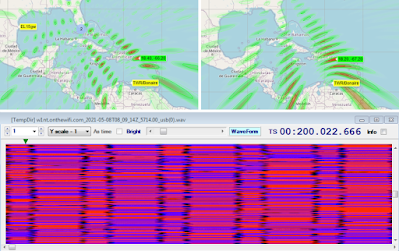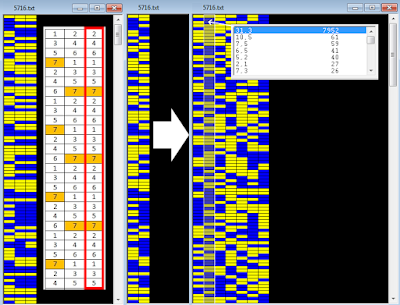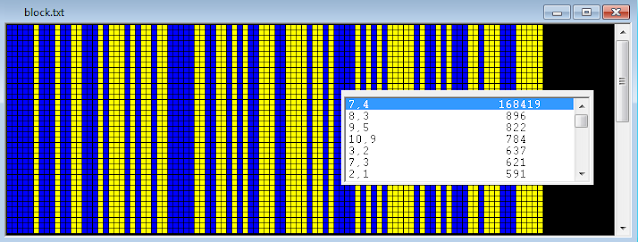I was just monitoring some interesting sequences of 2400Bd PSK bursts occupying 3 out of 6 channels (each 3 KHz width) according to alternate timings of 40 and 20 seconds: frequencies 5742.5, 5748.5, and 5757.5 (all USB). The 119.6 ms ACF value corresponds to a framing of 287 symbols @2400Bd, ie the waveform STANAG-4539: more precisely, according to its self-identifying feature, a 32QAM modulation at 8000bps speed (Figure 1).
 |
| Fig. 1 - STANAG-4539 framing structure |
Unfortunately, I was not able to get the expected 32QAM constellation but only few states of the outer 32QAM ring (Figure 2).
 |
| Fig. 2 |
I was a bit puzzled until I realized I was seeing an already known signal, more precisely the UK MoD 12800 bps 64QAM bursts [1]: the signals were just badly-tuned (300 Hz frequency offset).
A question arose almost immediately: why, despite the out-of-tuning, the signals are recognized as a 32QAM/8000bps modulation with a sub-carrier error of only 0.2 Hz? I thought about a decoder error, but examining the 103 preamble' symbols that carry information regarding the data rate and interleaver settings, I found that those are actually different in the two cases of 5757.20 and 5757.50 Hz (Figure 3).
 |
| Fig. 3 - data rate and interleaver settings |
I repeated the measurements of modulation and speed using other tuning frequencies, results are in the table below. Notice the discrepancies between the tuning frequency and the error detected by the decoder, expecially in 5757.20 and 5757.50 cases where the signal seems to be exactly tuned:
According to SATANAG-4539 #2.1, the accuracy of the sub-carrier frequency shall be 3×10^-5, ie a max tollerance of ±172 Hz @5,757 MHz is allowed: probably the autobaud feature fails since that kind of "symbols distortion"?
Assuming 64QAM/12800bps as the actual mode (as already assumed at the time), I tried to demodulate a same single burst using two different decoders (say A and B, without naming them). The expected length of the bitstream will be:
13 frames × 256 = 3328 symbols × 6 = 19968 bit
 |
| Fig. 4 |
- decoder A, 1536-bit length of the resulting bitstream, seems to successfully demodulate only one frame (1 × 256 × 6)
- decoder B, 36864-bit length of the resulting bitstream, seems to demodulate 12-out-of-13 frames and, in some way, duplicate the results (12 × 256 × 6 × 2)
(the 5750.20 KHz signal was resampled to 8000 Hz before its demodulation).
 |
| Fig. 5 |












